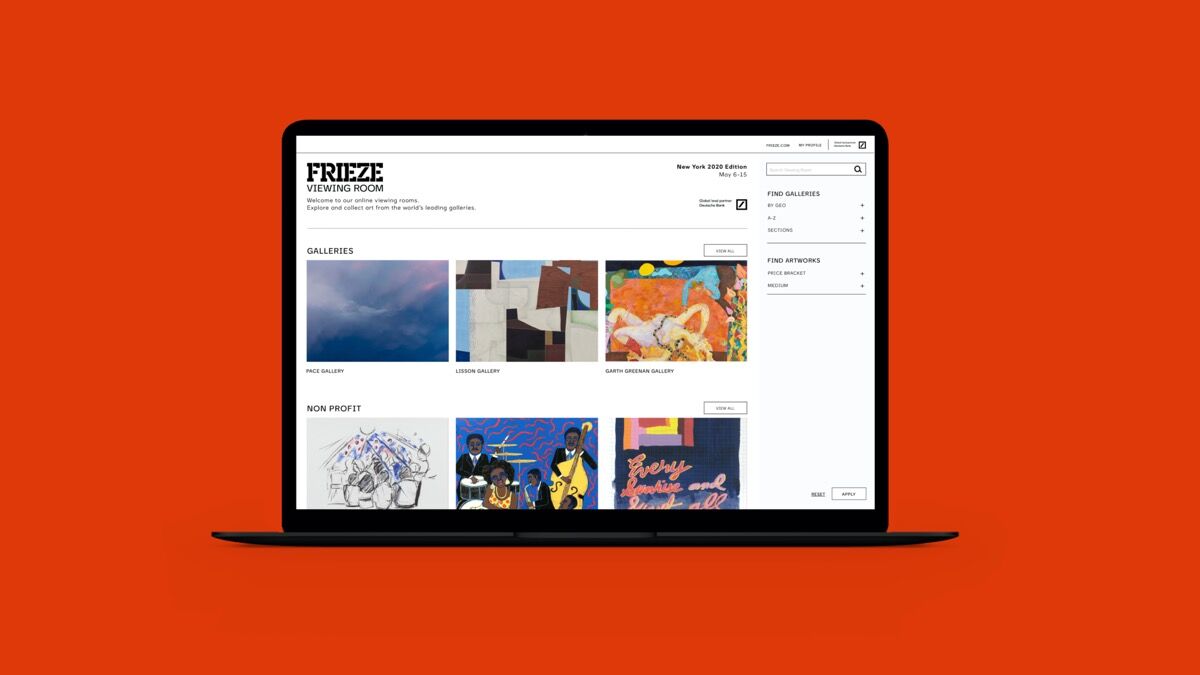Art Market
Will Online Viewing Rooms Increase Price Transparency at Galleries?

Courtesy of Frieze, Pace, Lisson Gallery, Garth Greenan Gallery and Allied Editions.
As I’ve reported on art fairs over the past few years, I’ve become accustomed to a degree of caginess about pricing. Some gallerists decline to share dollar amounts or price ranges—sometimes they won’t even distribute checklists of artworks in their booths. So I was surprised to visit Art Basel in Hong Kong’s online viewing rooms, which were open from March 18th to 25th in lieu of the yearly in-person fair (canceled due to the COVID-19 pandemic), and find specific prices or ranges listed for each of the 2,000-plus artworks on offer. Several galleries have also created new virtual platforms over the past few weeks that list prices.
Digital initiatives and price transparency go hand in hand, a number of industry professionals told me. Though overall online art sales declined by 2 percent from 2018 to 2019, according to the report “The Art Market 2020” (coinciding with a slight drop in the overall market), galleries continue to put resources and new ideas into how they present themselves digitally. As more dealers have launched online viewing rooms, they’ve also become more open to publishing information that was once closely guarded. Ultimately, galleries embrace both strategies for related reasons: to reach a larger audience, and to make sales more seamless.
Art Basel global director Marc Spiegler is careful to note that COVID-19 isn’t solely responsible for galleries and fairs overhauling their digital strategies. As he sees it, these shifts sped up as the industry adapted to its new, online-only existence. He also noted that Art Basel didn’t force participating galleries to post their exact prices—some works had price ranges spanning hundreds of thousands of dollars.
Sam Orlofsky, a director at Gagosian, is cautious about predicting how digital efforts precipitated by COVID-19 will play out in the long run. Initially, he believed our socially distanced circumstances would accelerate the art world’s embrace of digital platforms and the coinciding price transparency. Now, he said, he’s less sure “because there’s a headwind in the market. People may be willing to test this out. But if the market is in such a stark state, they may wrongly conclude it’s a failed experiment. There may be a backdraft.”
Acquiring minds want to know
Spiegler and his team only decided to include pricing in their viewing rooms after careful consideration. To not do so, he said, “creates one more hitch in the process of acquisition” for interested buyers. He noted that collectors have always sought transparency, and they appreciated the new approach. While some dealers were initially hesitant, no one significantly pushed back.
Loring Randolph, artistic director of the Americas at Frieze Art Fair—which yesterday announced details of its online viewing rooms, running in place of its canceled New York edition from May 6th to 15th—found similar receptivity among participating galleries: None pushed back against the fair’s recommendation to list prices. “Indicating the price makes it easier to engage an audience that is ready to buy,” said Randolph. Additionally, since collectors can filter artworks by price range, listing specific prices allows artworks to become easily searchable and viewed by more interested buyers.
Randolph said she understands the potential pitfalls of transparent pricing. Galleries may not want the public to know if an artist’s prices are staying flat or jumping significantly, which could indicate an unhealthy market and turn away would-be buyers. “Galleries are trying to protect their artists,” she said.
Spiegler said some galleries don’t put any information—not even wall labels—in their traditional fair booths, “because they’re trying to start a conversation” with fair attendees. This practice raises an interesting question: To whom does a lack of information look inviting? Some fairgoers, particularly those new to the scene, may feel intimidated—not encouraged to converse—if the most fundamental information is withheld. In any case, such person-to-person connection is impossible right now.
Public pricing presumed

Albert Oehlen, Untitled, 1988, in Gagosian's Art Basel Hong Kong online viewing room, 2019. © Albert Oehlen. Courtesy of Gagosian.
Most other industries have already settled the question of whether to share prices online, as they’ve more quickly adapted to the web. Spiegler noted this is the status quo for online marketplaces. “The digital tends to be a more transparent environment. To the extent that you already had people pushing into digital, you had people pushing in this direction,” he said, citing the long-standing transparency in the online viewing rooms of both Gagosian and David Zwirner (the latter was the first major gallery to launch one, back in 2017).
“In addition to transparency, we find prices a critical educational tool for collectors who are new to our program and are learning about our artists and estates,” said Elena Soboleva, who joined David Zwirner as its first-ever online sales director in 2018. In other words, sharing prices might actually lead to a collector’s long-term investment in multiple gallery artists—not just the one that initially brought the collector to the site. In 2019, David Zwirner’s online sales enjoyed 400 percent growth, Soboleva said; both museums and individuals have made purchases through the gallery’s website.
Yet the price transparency strategy has its detractors. Jane Lombard Gallery has opted to omit pricing on both this site and in its own viewing rooms. “By leaving out the prices, we are more likely to have conversations with those who may be interested in the work,” a spokesperson for the gallery said. That assertion suggested a belief—opposite to what others I spoke to said—that online and in-person sales can occur in similar ways. The gallery added it will continue to explore the possibilities of virtual viewing rooms and is “considering listing prices in the near future.”
In the Dallas Art Fair (DAF) online viewing rooms, which opened for sales yesterday, price listing wasn’t mandatory, but strongly encouraged (Jane Lombard Gallery, notably, has listed prices for all the works in its virtual DAF booth). As more fairs adopt this model, more dealers are reckoning with their long-standing beliefs about discretion. “Including a price can lead to more meaningful conversations and that can lead to sales in this situation,” said DAF director Kelly Cornell. In a marketplace where it’s now impossible to have an in-person, physical response to art, price transparency is “making the process more direct.”
Orlofsky concurred. “Someone would be discouraged by not knowing how much something costs,” he said. “If you’re trying to sell something to a stranger, you want to encourage them.” Last year, Orlofsky made news when, through a Gagosian viewing room, he sold an untitled canvas by
, which had a public asking price of $6 million.
By opting to list prices in the gallery’s online portals, Orlofsky noted, “we took a risk and ran an experiment that the upside would outweigh the downside.” That possible downside includes “making a primary market artist vulnerable,” or, in the case of a secondary market sale, “disclosing a private arrangement you have with a consignor,” he said.
Supporting artists and building trust are key to a gallery’s business model, but Orlofsky doesn’t think that disclosing prices has to weaken either of these efforts. With good communication—“clear and thorough conversations” with both artists and consignors—the gallerist can convey why it’s in everyone’s best interest to present works with their prices.
Context before commerce

Sarah Sze, Picture Perfect (Times Zero), 2020. © Sarah Sze. Photo by Rob McKeever. Courtesy of Gagosian.
Robert Dimin, a partner at Denny Dimin Gallery, also echoed artists’ concerns over price transparency. When Denny Dimin experimented with an online shop in 2016, the gallery received pushback from artists who were worried, he said, about the “excessive commercial element.” He’s realized that what’s most important to artists isn’t secrecy, but context. When the gallery launched a virtual exhibition space, it began posting essays and videos to accompany the artworks. Interested collectors are no longer browsing a catalog of objects with price tags, but learning stories about people and what they make.
Over the next few months, Gagosian is presenting an “Artist Spotlight” series online, focused on artists whose shows have closed (or not opened at all) due to COVID-19. For 48 hours, one of each selected artist’s artworks will be available, with pricing information provided. On April 8th, the program launched with
. Her 2020 multimedia painting Picture Perfect (Times Zero), which was priced at $275,000, sold. Interested viewers could still click the “Inquire” button to learn about other available artworks.
Orlofsky believes digital savviness will determine which small and medium-size galleries ultimately survive in an industry that increasingly favors its major players. Even working with some of the world’s most famous artists at Gagosian, he said, the artists who receive the most inquiries are those with the most successful social media. He added that he wouldn’t be surprised if, in five years, all gallery databases are accessible via their websites.
Looking forward to the return of real, multidimensional art fairs with more visitors than can reasonably fit into Zoom chats, Spiegler doesn’t anticipate any great change in how galleries will present their works. “I’m pretty certain galleries won’t start posting prices in booths,” he said.
Paris-based dealer Kamel Mennour agreed. In physical fairs, he said, “we will probably carry on as usual, with our sales team being in the booth, ready to help and inform collectors and prospects.” They will share prices when asked.
For now, Mennour is continuing to innovate in the digital realm. He has mounted an online viewing room, titled “From Home,” which situates clearly priced artworks together in a virtual gallery. By clicking on various artworks, the viewer can read a more comprehensive story about the paintings and sculptures, as well as the artists who made them.
“Today, we have found ourselves living in a world where we can either retreat in fear or connect and move forward digitally,” said Mennour. He’s chosen the latter approach.
Alina Cohen is a Staff Writer at Artsy.

No comments:
Post a Comment